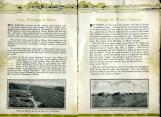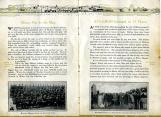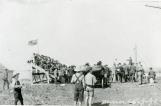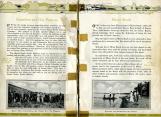2
The Grand Trunk Pacific Railway built a new line from Edmonton to Calgary, bringing it through the newly populating territory around Buffalo Lake.The following story about how this action led to the creation of Mirror, comes from the book, "Land of the Lakes", by the Lamerton Historical Society, and is told through the eyes and ears of the descendants of the people who were actually there at the time:
* * * * * * * * * * * * *
It had been expected that Lamerton would be the site of the divisional point the Grand Trunk Pacific Railway intended to build on this new line, but the GTP was unable to reach an agreement with Valentine Neis, of Lamerton, over the sale of land, so it was decided to move the proposed centre about 2 miles south, where a whole new town would be created.
The development of this new site was put into the hands of the Transcontinental Townsite Company Ltd.
They purchased the homesteads of the two Clarks, Lewis and his father, the J. Setter homestead, the A. Anderson quarter, and the forty acre block granted the Anglican church
(St. Monica's) at the time of it's establishment. This block lay in the southwest corner of the Anderson homestead. In all they purchased nearly two sections of land.
In addition, there is evidence that the company also purchased the Alberta School Land S.E. 29-40-22, and the C.P.R. section, 21, south of the present highway 50.
W. Merkley also sold his homestead east of highway 21 to the company.
The proposed townsite was about 1000 acres in extent. It was laid out in blocks wih streets running east/west and avenues running north/south. Areas were also set aside for parks, schools and churches, and of course for the rail yards, train station and roundhouse. There was also a more resort type section mapped out around the lake area.
For the town, two boulevards were planned and named Whitefriar Boulevard, now known as the sloping road that runs northeast to the highway, and Northcliffe Boulevard, which is the road that slopes SE to the highway.
From the railroad east to the present highway 21, and from the north and south entrances of the sloping roads, two miles apart, the land was sureyed into blocks and then into lots.
Why the London Daily Mirror was chosen, we do not know, but the new town was advertised as, "Mirror, The City Beautiful" and named for this newspaper.
Many avenues were named after members of the Daily Mirror staff in London, but some concession was made to the local area, because some of the streets were given such names as Lamerton, Jaques, Clarke, Setter, Brindle, Marryatt, Westhead, Mather, Dunham and Cook, some of our early settler families.
An extensive advertising campaign was carried out with such extravagant claims as, "Mirror, the heart of the world famous country that will some day be the home of fifty million people."
They urged prospective business men from Eastern Canada, the US, England and Europe and even Australia to settle there. Interest was aroused to such an extent that a special train was run from Winnipeg to Mirror, carrying prospective buyers.
It was planned to have an auction sale of lots on the same day that the first passenger train would pass through Mirror, July 11, 1911.
People from the country around flocked to the sale, most of them out of curiousity, and businesses both from Lamerton and from farther away set up tents to do immediate business out of, until they purchased the lots on which they would build their permanent stores and shops.
As soon as the train pulled in that evening at 7pm, the auctioning of lots began. The buyers spilled off the train and up to the sale, anxious to get in on the bidding.
The average price for a lot was around $400., with some going as high as $1500 (the brochure says $300 to $2075. was the price range). Five hundred and seventy-seven lots were sold in two days for a total of $251,648.
This was a highly promotional and speculative venture that proved very successful for the company involved, and represented the most money invested in the same space of time in any new town in Western Canada.
* * * * * * * * * * * * *
4
Another view of the auction.This was an exciting event for the area, who seldom saw any strangers, never mind a whole auction full of people who were considering being their new neighbors.
Whole families came to be part of this event.
5
Front Cover of the Advertising Brochure to Create and Sell the Town of Mirror WorldwideJuly, 1911
Mirror, Alberta

6
This is the front cover of the brochure, which was sent all over the world, advertising the newly created townsite of Mirror, the expectations for it to become a huge population centre, and the tale of the main auctioning of the town lots, which had just occurred.This brochure was created to entice more investors to buy the remaining town lots and the lakeside lots they expected to create into a resort, and to relocate their families and businesses to this fine new town.
Following are the other pages of this compelling brochure.
In these pages is the heart of our story, the tale of what it was like in our area of the West at that time, and what this new townsite of Mirror was expected to become.
10
Pages 8 and 9 of the Advertising Brochure, 'Mirror, the City Beautiful'July, 1911
Mirror, Alberta

11
Pages 10 and 11 of the Advertising Brochure, 'Mirror, the City Beautiful'.July, 1911
Mirror, Alberta

12
Pages 12 and 13 of the Advertising Brochure, 'Mirror, the City Beautiful'.July, 1911
Mirror, Alberta

13
Pages 14 and 15 of the Advertising Brochure, 'Mirror, the City Beautiful'.July, 1911
Mirror, Alberta

14
Pages 16 and 17 of the Advertising Brochure, 'Mirror, the City Beautiful'.July, 1911
Mirror, Alberta





